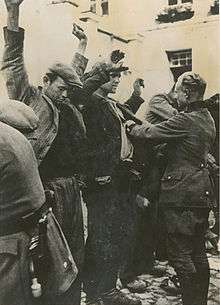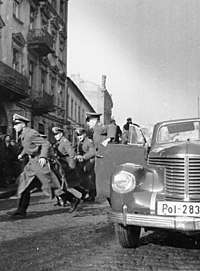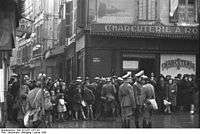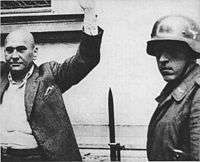Roundup (history)
A roundup[lower-alpha 1] was a widespread German World War II security and economic exploitation tactic used in occupied countries, especially in German-occupied Poland in which the SS, Wehrmacht and German police took captive at random thousands of civilians on the streets of subjugated cities. The civilians were captured in groups of unsuspecting passers-by or kidnapped from selected city quarters that had been surrounded in advance by German forces.[1]
| Łapanka | |
|---|---|
 | |
| Location | German-occupied Europe, predominantly Nazi occupied Poland |
| Period | World War II (1939–1945) |
Those caught in roundups were most often sent to slave labour in Germany, but some were also taken as hostages or executed in reprisal actions; imprisoned and sent to concentration camps or summarily executed in numerous ethnic-cleansing operations.[2]
History

The term łapanka, derived from the Polish verb łapać ("to catch"), carried a sardonic connotation due to the prior use of the word łapanka for the children's game known in English as "tag".
"Round ups, or lapankas, the Polish name they were known under, became an essential feature of life in Warsaw and precipitated much wider ferocity on both sides. (...) Whole streets were sealed off by police and soldiers and most trapped men and women were carted off to concentration camps or sent as slave labour to the Reich. Tram and trainloads of people, regardless of work documents, were herded like cattle into trucks, many never to see home or family again." - Ron Jeffery memoir, 1943[3]
Most people who were rounded up were transported to labour camps (Arbeitslager), including Auschwitz. Many Polish women were selected for sexual slavery. Many Polish children were kidnapped for adoption by German families. Some − those without proper documents or carrying contraband − were transported to concentration and death camps. Others, particularly Jews in hiding and Poles wanted for harboring them, were shot dead on the spot.
The term was also used for describing the tactic of cordoning-off of streets, and the systematic searching of buildings. For young men in their 20s and 30s, the only reliable defense against being taken away by the Nazis was the possession of an identity card (called Ausweis) certifying that the holder was employed by a German company or a government agency locally (for example, by the city utilities or the railways). Thus, many of those who were taken from cafes and restaurants in Warsaw on the night of December 5, 1940 were subsequently released after their documents had been checked.[4]

According to estimates, in Warsaw alone between 1942 and 1944 the Nazi łapankas claimed at least 400 victims every day, with numbers reaching several thousand on some days. On 19 September 1942, nearly 3,000 men and women, who had been caught in massive round-ups all over Warsaw during the previous two days, were transported by train-loads to slave labour in Germany.[2]
Targeted territories

Such roundups as Poland's łapanka were carried out by the Germans in other occupied countries as well, particularly in northern France, although not as extensively as in Poland. The French term for this practice was rafle, applied primarily to the rounding-up of French Jews. In Denmark and the Netherlands, a Nazi roundup was called razzia.
In historical terms, the razzia roundup was used in French colonial context for Muslim raids particularly to plunder and capture slaves from Western and Central Africa, also known as rezzou when practiced by the Tuareg. (See also: Barbary slave trade) The word was adopted from ġaziya of Algerian Arabic vernacular and later became a figurative name for any act of pillage, with its verb form razzier. The Soviets used similar tactics to round up middle-class Poles in the part of Poland that they occupied following the 1939 invasion of Poland. Men, women, and children were transported to labour camps in remote regions of the Soviet Union.[5]
Polish resistance

In 1940, one roundup was used by Home Army secret agent Witold Pilecki to gain entry into the Auschwitz camp set up at about that time for Polish prisoners.[6] There, he gathered first-hand intelligence on the camp, and organised inmate resistance.[7] Pilecki deliberately went out into the street during a Warsaw roundup on 19 September 1940, and was arrested by the Germans along with other civilians. Auschwitz was the main destination for the Poles from beyond the ghetto.[6] There he organised Związek Organizacji Wojskowej (ZOW, the Military Organization Association), and in November 1940 sent its first report about the camp and the genocide being committed there to Home Army headquarters in Warsaw.[8][9]
.jpg)
In retribution for roundups as acts of Nazi terror, the Polish resistance carried out attacks on German forces and prepared lists of Nazi leaders to be eliminated for their crimes against civilians.[10] Nazi personnel responsible for organizing roundups, such as members of local unemployment offices, the SS, SD, and German police, were sentenced to death by the Special Courts of the Polish Underground for crimes against Polish citizens during the Occupation of Poland. Because of the particular brutality of the police, the AK killed 361 gendarmes in 1943, and 584 in 1944. In Warsaw alone, ten Germans were killed daily. From August to December 1942, the AK launched 87 attacks on the German administration and members of the apparatus of terror. In 1943 this number rose radically − the AK carried out 514 attacks during the first four months.[11] In an underground operation known as Operacja Główki (Operation Heads), Polish underground combat units from Kedyw eliminated roundup organizers such as:
- Kurt Hoffman - chief of the unemployment office in Warsaw responsible for organising roundups of Poles. Executed by the AK on 9 April 1943.[12]
- Hugo Dietz - Hoffmann's assistant. Executed on 13 April 1943.
- Fritz Geist - chief of the unemployment office department. Killed on 10 May 1943.
- Willi Lübbert - worked at the unemployment office and organised roundups of Poles to be sent to Nazi labor camps. Executed on 1 July 1944.
- Eugen Bollodino - worked at the unemployment office and organised roundups of Poles to be sent to Nazi labor camps. Executed by combat patrol unit DB-17 on 8 June 1944.
In culture
Criticism of the German practice of roundups was the theme of the most popular song of occupied Warsaw, Siekiera, motyka (Polish for Axe, Hoe).[13] In 1943 it was published by the Polish resistance's underground presses in the book Posłuchajcie ludzie... (Listen, folks), one of the bibuła publications of the Komisja Propagandy (Propaganda Commission) of the Armia Krajowa (Home Army). The song was also reproduced in several books and records after the German occupation ended. In 1946 the song was featured in the first Polish movie created after the war, Zakazane piosenki, directed by Leonard Buczkowski.
See also
| Wikimedia Commons has media related to Police raids of Nazi Germany. |
Notes
References
- Ron Jeffery (1989), Red Runs the Vistula. Nevron Associates Publ., Manurewa, Auckland, New Zealand. ISBN 090873400X via Google Books, snippet.
- Władysław Bartoszewski, 1859 dni Warszawy (1859 Days of Warsaw), pp. 303-4.
- Ron Jeffery, "Red Runs the Vistula", Nevron Associates Publ.,Manurewa, Auckland, New Zealand 1985
- Władysław Bartoszewski, 1859 dni Warszawy (1859 Days of Warsaw), p. 167.
- Norman Davies (1996), Europe: A History, Oxford University Press, pp. 1002-3. ISBN 0198201710.
- Snyder, Timothy (2010). Bloodlands: Europe Between Hitler and Stalin. New York: Basic Books. p. 281. ISBN 978-0-465-00239-9.CS1 maint: ref=harv (link)
- Jozef Garlinski (1975), Fighting Auschwitz: the Resistance Movement in the Concentration Camp, Fawcett, ISBN 0-449-22599-2; reprinted by Time Life Education, 1993. ISBN 0-8094-8925-2.
- Adam Cyra, Ochotnik do Auschwitz - Witold Pilecki 1901-1948 [Volunteer for Auschwitz], Oświęcim 2000. ISBN 83-912000-3-5
- Hershel Edelheit, History of the Holocaust: A Handbook and Dictionary, Westview Press, 1994, ISBN 0-8133-2240-5,Google Print, p.413
- Henryk Witkowski "Kedyw okręgu warszawskiego AK w latach 1943-1944", Warszawa 1984
- EUGENIUSZ DURACZYŃSKI "WOJNA I OKUPACJA", Wiedza Powszechna 1974
- Władysław Bartoszewski, 1859 dni Warszawy, Kraków, 1974
- Stanisław Salmonowicz, Polskie Państwo Podziemne, Wydawnictwa Szkolne i Pedagogiczne, Warszawa, 1994, ISBN 83-02-05500-X, p.255
References
- Władysław Bartoszewski, 1859 dni Warszawy (1859 Days of Warsaw), Kraków, 1974.
- Norman Davies, Europe: A History, ISBN 0-19-520912-5.
- Ron Jeffery, "Red Runs the Vistula", Nevron Associates Publ.,Manurewa, Auckland, New Zealand 1985
- Richard C. Lukas "Forgotten Holocaust - The Poles Under German Occupation 1939-1944" Hippocrene Books 1997 ISBN 0-7818-0901-0
- Tomasz Strzembosz, Akcje zbrojne podziemnej Warszawy 1939-1944, Warszawa, 1978.
- Stachiewicz Piotr, Akcja "Kutschera", Książka i Wiedza, 1987, ISBN 83-05-11024-9.
- Henryk Witkowski, Kedyw okręgu Warszawskiego Armii Krajowej w latach 1943- 1944, Fakty i Dokumenty,(Kedyw of Warsaw area. Facts and documents) 1984.

